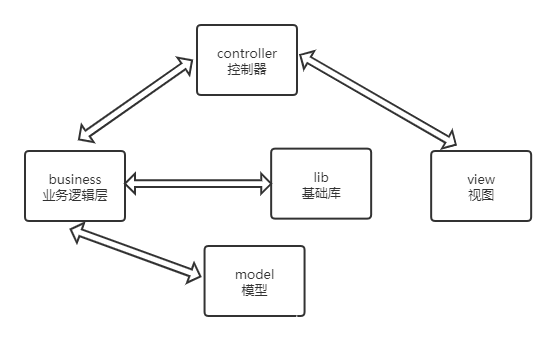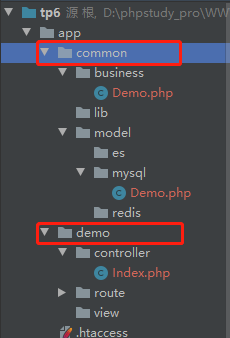架构分层
一、分层意义
意义我觉得最重要的是方便维护,如果代码没有分层,都是写在控制器里,包括了各种参数校验,各种情景判断,各种数据查询返回结果不同,十分混乱,出现问题很难定位,修改需求十分头疼,良好的分层架构可以解决后顾之忧。
二、代码架构

这里借用了某课网老师的图,我又重新画了一遍,我们把代码分为以上5个模块,它们的作用分别为:
| 模块 | 作用 |
|---|---|
| 控制器 controller | 负责调用业务层,返回组装数据给视图层或api接口 |
| 业务逻辑层 business | 负责调用第三方库或模型层获取数据 |
| 基础库 lib | 负责封装特定功能的库或引用第三方类库 |
| 模型层 model | 负责连接数据库返回数据 |
| 视图层 view | 负责返回数据到前台 |
三、common层设计
有些模块对于多个应用是可以公用的,所以可以创建一个
common目录存放所有应用公共的文件,common目录与其他应用目录同级。如business、lib、model等。
注意:修改文件目录,记得修改文件命名空间和引用该文件的地方。

考虑到后面操作数据可能会用到redis等,所以这里对model再分层。
四、实践代码
Model:
<?php
namespace app\common\model\mysql;
use think\Model;
class Demo extends Model
{
public function getDemoDataByCategoryId($cateId, $limit = 10){
return $this->where("cate_id", $cateId)->limit($limit)->select()->toArray();
}
}
Business:
<?php
namespace app\common\business;
use app\common\model\mysql\Demo as DemoModel;
class Demo
{
public function getDemoDataByCategoryId($cateId, $limit = 10){
$model = new DemoModel();
$results = $model->getDemoDataByCategoryId($cateId, $limit);
if(empty($results)){
return [];
}
return $results;
}
}
controller:
<?php
namespace app\demo\controller;
use app\BaseController;
use app\common\business\Demo;
class Index extends BaseController
{
public function test(){
$cateId = $this->request->param("cate_id",0,"intval");
if(empty($cateId)){
return show(config("status.error"), "参数错误");
}
$demo = new Demo();
$results = $demo->getDemoDataByCategoryId($cateId);
return show(config("status.success"), "ok", $results);
}
}